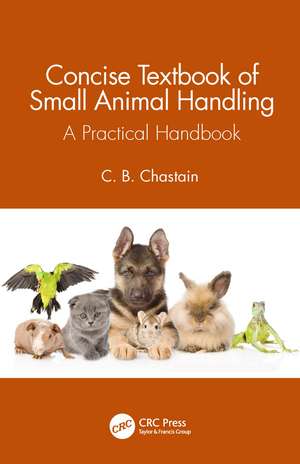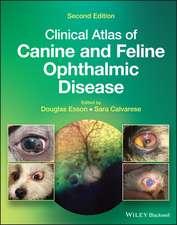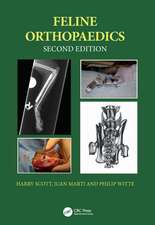Concise Textbook of Small Animal Handling: A Practical Handbook
Autor C. B. Chastainen Limba Engleză Hardback – 25 apr 2022
- Handler safety
- Animal safety
- Sanitation
- Approach and capture
- Routine handling and release procedures
- Handling for medical procedures
- Use and supply sources of restraint equipment
You can hear the author discuss the topics covered in this book on his weekly podcast ‘Better Animal Handling’: https://www.betteranimalhandling.com/
| Toate formatele și edițiile | Preț | Express |
|---|---|---|
| Paperback (1) | 245.79 lei 3-5 săpt. | +21.79 lei 6-12 zile |
| CRC Press – 15 mar 2022 | 245.79 lei 3-5 săpt. | +21.79 lei 6-12 zile |
| Hardback (1) | 681.73 lei 6-8 săpt. | |
| CRC Press – 25 apr 2022 | 681.73 lei 6-8 săpt. |
Preț: 681.73 lei
Preț vechi: 802.04 lei
-15% Nou
Puncte Express: 1023
Preț estimativ în valută:
130.46€ • 136.03$ • 108.43£
130.46€ • 136.03$ • 108.43£
Carte tipărită la comandă
Livrare economică 21 martie-04 aprilie
Preluare comenzi: 021 569.72.76
Specificații
ISBN-13: 9780367628147
ISBN-10: 0367628147
Pagini: 242
Ilustrații: 51 Tables, black and white; 96 Line drawings, color; 96 Illustrations, color
Dimensiuni: 156 x 234 x 14 mm
Greutate: 0.78 kg
Ediția:1
Editura: CRC Press
Colecția CRC Press
ISBN-10: 0367628147
Pagini: 242
Ilustrații: 51 Tables, black and white; 96 Line drawings, color; 96 Illustrations, color
Dimensiuni: 156 x 234 x 14 mm
Greutate: 0.78 kg
Ediția:1
Editura: CRC Press
Colecția CRC Press
Public țintă
Further/Vocational Education and Undergraduate CoreNotă biografică
C.B. Chastain is a professor emeritus and adjunct professor of veterinary medicine and former Section Head of Small Animal Medicine and Associate Dean for Academic Affairs at the University of Missouri. He also has been on faculty at Iowa State University and Louisiana State University. In addition to being a Diplomate of the American College of Veterinary Internal Medicine, he has authored journal articles, book chapters in veterinary medical and allied publications, and textbooks on clinical endocrinology and animal handling and physical restraint. He was also chief editor of the monthly journal, Advances in Small Animal Medicine and Surgery for 20 years. Prior to entering academic veterinary medicine, he was a horse wrangler for a horseback riding stable and a licensed guide in Rocky Mountain National Park, Colorado; worked in mixed animal veterinary medical practices in Missouri, Illinois, and New Mexico; and a captain in the U.S. Air Force Veterinary Corps. He has handled, restrained, and trained a variety of animals in differing environments and taught aspects of animal handling for more than 40 years at the undergraduate and professional school levels. Currently, he is a professor and consultant for Veterinary Online Programs at the University of Missouri.
Recenzii
Safe animal handling is a foundation of training for veterinarians, veterinary technicians, and veterinary assistants. With the popularity of various low stress training and certifications for veterinary staff it is always important to stay abreast of the latest in animal restraint. This handbook is an easy to use and practical guide for various species. I particularly found the exotic companion mammal, bird, and reptile sections of great interest. The artwork in the handbook adds to the text's descriptions so readers are not left self-interpreting how the technique should be performed. I appreciate the author's attention to not only human safety but also the welfare of the animals undergoing restraint.
I think this handbook would serve any veterinary professional or clinic well. I also think it is a great substitute for the larger animal restraint texts available as the conciseness highlights the material readers are often looking for.
Stephen Cital RVT, SRA, RLAT, CVPP, VTS-LAM, Stanford University, USA
Safe animal handling is a foundation of training for veterinarians, veterinary technicians, and veterinary assistants. With the popularity of various low stress training and certifications for veterinary staff it is always important to stay abreast of the latest in animal restraint. This handbook is an easy to use and practical guide for various species. I particularly found the exotic companion mammal, bird, and reptile sections of great interest. The artwork in the handbook adds to the text's descriptions so readers are not left self-interpreting how the technique should be performed. I appreciate the author's attention to not only human safety but also the welfare of the animals undergoing restraint.
I think this handbook would serve any veterinary professional or clinic well. I also think it is a great substitute for the larger animal restraint texts available as the conciseness highlights the material readers are often looking for.
Stephen Cital RVT, SRA, RLAT, CVPP, VTS-LAM, Stanford University, USA
This is an excellent textbook - I would even go to say an essential textbook for anyone interested or going into the animal care industry or interested in studying any animal management/welfare course. I have recommended this text to our librarian and undergraduates on the BSc degree course. The book is suitably designed outlining the handling and restraint methods that can be used along with suitable illustrations / photographs of the techniques. Pros and cons as well as considerations for animal and human welfare / safety are nicely described.
Catheryn Hancock BVetMed MSc DWEL certAVP PGcertEd PGcertVA MRCVS
I think this handbook would serve any veterinary professional or clinic well. I also think it is a great substitute for the larger animal restraint texts available as the conciseness highlights the material readers are often looking for.
Stephen Cital RVT, SRA, RLAT, CVPP, VTS-LAM, Stanford University, USA
Safe animal handling is a foundation of training for veterinarians, veterinary technicians, and veterinary assistants. With the popularity of various low stress training and certifications for veterinary staff it is always important to stay abreast of the latest in animal restraint. This handbook is an easy to use and practical guide for various species. I particularly found the exotic companion mammal, bird, and reptile sections of great interest. The artwork in the handbook adds to the text's descriptions so readers are not left self-interpreting how the technique should be performed. I appreciate the author's attention to not only human safety but also the welfare of the animals undergoing restraint.
I think this handbook would serve any veterinary professional or clinic well. I also think it is a great substitute for the larger animal restraint texts available as the conciseness highlights the material readers are often looking for.
Stephen Cital RVT, SRA, RLAT, CVPP, VTS-LAM, Stanford University, USA
This is an excellent textbook - I would even go to say an essential textbook for anyone interested or going into the animal care industry or interested in studying any animal management/welfare course. I have recommended this text to our librarian and undergraduates on the BSc degree course. The book is suitably designed outlining the handling and restraint methods that can be used along with suitable illustrations / photographs of the techniques. Pros and cons as well as considerations for animal and human welfare / safety are nicely described.
Catheryn Hancock BVetMed MSc DWEL certAVP PGcertEd PGcertVA MRCVS
Cuprins
Preface. Acknowledgments. Caution. Author Biography. SAFER ANIMAL HANDLING AND PHYSICAL RESTRAINT. Handling and Animal Welfare. The More Effective Handler: The Art of Firm Kindness. Conditions for Handling and Restraint. Risks of Injury. Risks of Disease to Handlers and Other Animals. Ethical Concerns. Legal Considerations. Roles of Chemical and Physical Restraint. Keys to Good Handling of All Animals. SMALL ANIMAL BEHAVIOR. Behavior and Handling. Predator or Prey Behavior. Animal Hierarchy: Social Dominance. Socialization with Humans. Flight Zone. Senses and Behavior. Resistance Behaviors. Species Differences in Aggression and Avoidance. Training Methods for Handling Animals. Health and Behavior. Stereotypic Behavior and Environmental Enrichment. Nutraceuticals for Control of Anxiety. Animal Behavior Specialists. DOGS. Natural Behavior of Dogs. Safety First. Approaching and Catching. Handling for Routine Care and Management. Walking Dogs. Lifting and Carrying Dogs. Handling for Common Medical Procedures. Special Equipment. Transporting Dogs by Automobile or Truck. CATS. Natural Behavior of Cats. Safety First. Approaching and Catching. Handling for Routine Care and Management. Handling for Common Medical Procedures. Special Equipment. OTHER SMALL MAMMALS. Natural Behavior of Small Mammals. Safety First. Mice. Rats. Hamsters. Gerbils. Guinea Pigs. Chinchillas. Degus. Sugar Gliders. African Pygmy Hedgehogs. Rabbits. Ferrets. Handling Small Mammals for Common Medical Procedures. COMPANION BIRDS. Types of Caged Companion Birds and Birds of Prey. Natural Behavior of Companion Birds. Safety First. Approaching and Catching. Handling for Routine Care and Management. Handling for Common Medical Procedures. Special Equipment and Procedures. REPTILES. Types of Pet Reptiles. Natural Behavior of Reptiles. Safety First. Turtles and Tortoises (Chelonians). Snakes. Lizards. Handling of Reptiles for Common Medical Procedures. Transporting Reptiles. Appendix. Index.
Descriere
This instructional pocket reference condenses the most important aspects of small animal handling. It provides a portable, durable means of learning 'on the ground', as well as a convenient way to refresh on how to strive for safety and efficacy in animal handling techniques.




